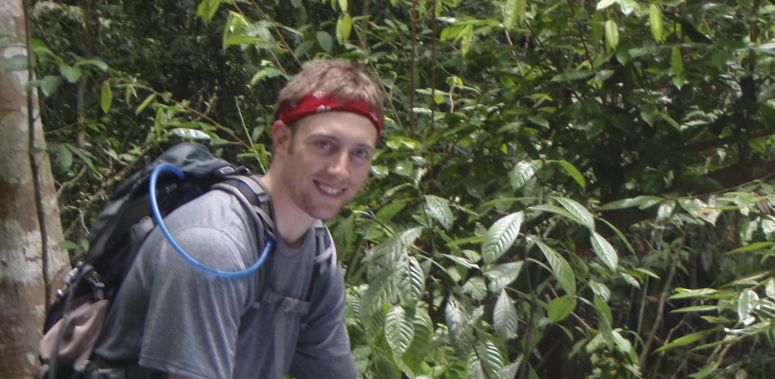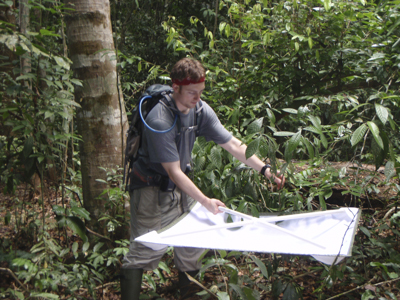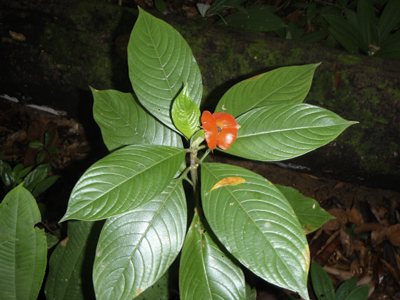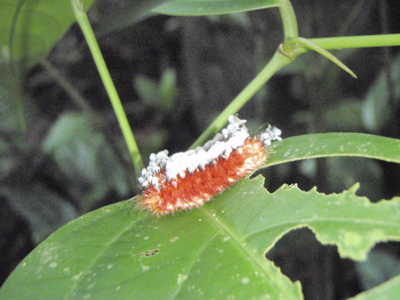Postdoctoral Fellow, Smithsonian Tropical Research Institute

From caffeine in coffee to tannins in wine to aspirin in headache remedies, plant chemical compounds play an important role in our everyday wellbeing. But beyond our personal needs, these compounds—which evolved as plant defenses against herbivores—are also helping scientists unlock the mysteries of our planet’s biodiversity.

Chemical ecologist Brian Sedio first became interested in plant chemistry and plant–herbivore ecology when he worked on a project in the Brazilian Amazon as a biology undergraduate. “I have always wanted to research chemical ecology at a community scale in a tropical forest,” says Dr. Sedio, “but rainforests are so chemically diverse that traditional methods of characterizing compounds from wild sources quickly becomes overwhelming. So I started looking at ways to overcome that challenge.”
By teaming up with UC San Diego chemist Pieter Dorrestein, Sedio was able to hone a method to more efficiently study the chemistry of complex biological samples with mass spectrometry, a method that provides a precise measure and visual representation of the chemical composition of a substance.
In January 2014, Sedio was awarded a Smithsonian postdoctoral fellowship, which combines these developments in chemical analysis with the Smithsonian’s expertise in emerging genomics technologies to characterize plant chemical defenses and the interactions with insect herbivores. “I chose to do my postdoctoral work here because there is no place in the tropical world that compares to the research infrastructure, the rich history of intense investigation in one locality, or the intellectual community offered by the Smithsonian Tropical Research Institute,” says Sedio.
Sedio and his postdoctoral advisor, Joe Wright, lead a Smithsonian Consortia-supported project conducting comparative research on plots at the Smithsonian Tropical Research Institute’s Barro Colorado Island in the Panama Canal, the Smithsonian Environmental Research Center in the Chesapeake Bay, and the Smithsonian Conservation Biology Institute in Front Royal, Virginia.

These research plots are part of the Smithsonian’s Forest Global Earth Observatory (ForestGEO) initiative, a multi-institutional network of scientists from around the world dedicated to studying forest function and diversity. ForestGEO currently comprises 53 research plots of roughly 50 hectares (approximately 125 acres) each, located across the Americas, Africa, Asia, and Europe, with a strong focus on the species-rich tropical regions.
On Panama’s Barro Colorado Island, for instance, there are more tree species than in all of the U.S. and Canada combined, which makes the diversity of life—and its chemical make up—in this ForestGEO plot an ideal focus for Sedio’s work. The mass spectrometry techniques he has helped develop will allow him to do detailed comparisons of hundreds of chemical compounds at a scale that previously was impossible.
Even for Wright, who has more than 30 years of experience generating large datasets from tropical forests, the ability to study plant chemistry at the scale of a whole forest is a game-changer. “We’re up to our eyeballs in data,” says Wright. “Now the challenge is using those data in innovative ways.”
Sedio’s work will rely heavily on the Smithsonian’s expertise in using DNA barcode methods to more accurately identify the species of herbivores, fungal pathogens, and the plant species they ingest. “If you know which herbivore is eating which plants, then you can begin to understand the reasons these plants differ chemically,” he says.
“We can now test some of the most basic questions in science today,” says Sedio, “one of the most important being, ‘What determines species diversity?’ At the heart of any attempt to answer that lies the question of why tropical forests have so many different types of trees, and how ecologically similar species have all managed to live in such close proximity.

Because it doesn’t get cold enough in the tropics, Sedio explains, plants there are exposed to their enemies—including insect herbivores and fungal pathogens—throughout the year. In response, tropical plants have evolved a wide variety of novel chemical defenses for protection, such as alkaloids, tannins, flavonoids, and terpenoids. This variation in defensive strategies contributes greatly to diversity and function of the forest.
Understanding the chemical similarities among species and how they interact with their natural enemies has numerous benefits. “This might help us design more productive forest plantations in the tropics, which could ease the pressure for clear-cutting timber in wild forests,” says Sedio. “The chemical networks we are discovering are also invaluable to chemists trying to discover novel pharmaceuticals. Our ultimate goal is to increase the value of the forest, here in Panama and worldwide, so we will all realize the economic benefit of preserving these unique resources.”
Sedio also hopes that mass spectrometry and DNA barcoding will eventually be applied at all ForestGEO plots. “The Smithsonian is driving the application of these cutting-edge techniques, including the use of molecular networking and DNA barcoding, to overcome traditional challenges to global ecology.”
“If we can leverage these new technologies to really understand how plant–herbivore interactions and chemical evolution are driving things,” he continues, “then the sky is the limit in terms of what we can do.”
